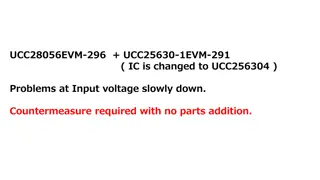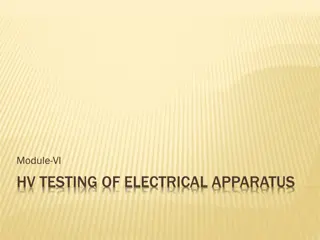Load Frequency Control in Power Systems
Electric power systems require Load Frequency Control (LFC) to maintain a uniform frequency, distribute load among generators, and manage tie-line interchange schedules. LFC detects frequency changes, generates real power commands to adjust torque, and ensures stability within specified limits. Reas
9 views • 38 slides
Measurement Scales and Scaling Techniques
Measurement scales play a crucial role in marketing research, with techniques like scaling helping to categorize data. The content discusses four types of measurement scales: nominal, ordinal, interval, and ratio, outlining their characteristics and differences. Scaling techniques involve placing re
5 views • 7 slides
Chopper Amplifiers: Applications and Benefits
A chopper amplifier is an electronic circuit methodology used to minimize signals, DC offsets, noise, and low-frequency circuit conditions in operational amplifiers. Chopper stabilized amplifiers employ modulation to reduce noise, while chopper amplifiers find applications in battery chargers, elect
0 views • 7 slides
Voltage Drop in Electrical Systems
Electrical calculations often focus on current or voltage drop to determine proper conductor sizes. Excessive voltage drop can lead to issues like flickering lights, poor heating, and overheating of motors, requiring attention to wire sizes and the National Electrical Code recommendations. Explore t
0 views • 20 slides
Voltage in Circuits: Effects and Applications
Explore the concept of voltage in circuits, its significance in electricity, and the effects of varying voltages on components like bulbs, motors, and buzzers. Discover how different voltage levels impact the brightness of a bulb, the loudness of a buzzer, and the overall performance of electrical d
1 views • 11 slides
Multidimensional Scaling and Unsupervised Learning Methods
Multidimensional scaling (MDS) aims to represent similarity or dissimilarity measurements between objects as distances in a lower-dimensional space. Principal Coordinates Analysis (PCoA) and other unsupervised learning methods like PCA are used to preserve distances between observations in multivari
3 views • 21 slides
Performance of Transmission Lines in Electrical Engineering
The performance of a transmission line in power systems is critical for efficient operation. Factors such as voltage drop, line losses, and transmission efficiency are key considerations in design and operation. The line parameters of resistance, inductance, capacitance, and shunt conductance play c
2 views • 26 slides
DC Machine Armature Windings Overview
Learn about the construction and types of armature windings in DC machines, including lap wound and wave wound armatures. Discover how lap wound armatures are suitable for low voltage, high current applications, while wave wound armatures are used in high voltage, low current scenarios. Understand t
0 views • 18 slides
Transmission Operator Obligations in Under-Frequency Load Shedding
ERCOT Compliance ensures that Transmission System Operators (TSOs) and Distribution System Operators (DSOs) have automatic under-frequency load shedding circuits in place to provide load relief during under-frequency events. The TSOs are required to shed a specific percentage of their connected load
2 views • 6 slides
Feedback Amplifiers in Electronic Circuits
Feedback amplifiers play a crucial role in electronic circuits by providing mechanisms for controlling gain, stability, and overall performance. There are two basic types of feedback - positive and negative, each offering distinct advantages. The four ways of connecting feedback signals involve volt
1 views • 18 slides
Methods of Mark Adjustment in Educational Assessment
In educational assessment, methods like Z-score normalization, quadratic scaling, and piecewise linear scaling are used to adjust marks based on Gaussian distribution assumptions. Z-score normalization helps to adjust both mean and standard deviation, impacting the distribution of marks. Quadratic s
5 views • 25 slides
Overview of High Voltage Pulsed Stimulation (HVPS) in Medical Applications
High Voltage Pulsed Stimulation (HVPS) is a versatile form of electrical stimulation used in various medical applications such as wound healing, muscle reduction, nerve stimulation, and pain control. Originally developed in 1945, HVPS delivers monophasic current with unique features like fixed durat
0 views • 34 slides
Transistor Tuned Amplifiers: Operation and Analysis
Transistor tuned amplifiers consist of a parallel tuned circuit as the collector load, amplifying a specific frequency while rejecting others. The resonant frequency of the tuned circuit is crucial for amplification. A high Q circuit offers maximum voltage gain at the resonant frequency but decrease
0 views • 30 slides
Band-Gap Voltage References in Microelectronic Systems
Voltage references provide stable output voltages unaffected by variations in supply voltage, temperature, and process errors. This summary delves into the principles of band-gap voltage references and their crucial role in creating precise control voltages for ADCs, DACs, and various other applicat
2 views • 14 slides
Dynamic Voltage and Frequency Scaling in Advanced VLSI
Explore the concepts of Dynamic Voltage and Frequency Scaling (DVFS) in Advanced VLSI design. Learn about the impact on clocking, STA, and testing, as well as considerations for selecting the right voltage and frequency settings. Discover how controlling voltage affects power consumption and computa
0 views • 51 slides
Zener Diodes for Voltage Regulation
Zener diodes are special diodes designed to have a low reverse breakdown voltage, making them ideal for voltage regulation purposes. When biased in the reverse direction, they provide a stable voltage output regardless of changes in current. This property can be effectively utilized to stabilize vol
0 views • 18 slides
High Frequency Market Microstructure - A Comprehensive Overview
Delve into the intricate world of high-frequency market microstructure with a detailed exploration of how traders operate, market structures, regulatory influences, and the evolution of trading platforms. Uncover the birth of High-Frequency Trading (HFT), the strategies employed by high-frequency tr
1 views • 12 slides
Requirements for Grid Connection of Wind Farms in Hellenic Grid Code
The Hellenic Grid Code outlines the specific requirements for wind farms regarding grid connection, including frequency and voltage operation boundaries, active/reactive power boundaries, voltage/reactive power control, and load-frequency control. These requirements ensure the safe and efficient int
0 views • 6 slides
Two-Way Frequency Tables in Data Analysis
Explore the concept of representing and interpreting data in two variables using two-way frequency tables. Learn about joint frequency, marginal frequency, and conditional relative frequency through a practical example involving gender and nail services. Discover how to target specific audiences bas
1 views • 15 slides
Input and Output Limitations in Op Amps
Explore the various input and output limitations in TI Precision Labs Op Amps as presented by Ian Williams and prepared by Art Kay and Ian Williams. Delve into common mode voltage, voltage swing, data sheet parameters translation, input and output stages, examples of common mode voltage, and potenti
0 views • 15 slides
Voltage Readings and Rules for Troubleshooting Wiring and System Issues
Data on voltage readings derived from bench testing in a controlled environment are provided as a reference for troubleshooting wiring and unit issues. General rules and guidelines for voltage measurements at various locations within the system are outlined, along with specific instructions for cont
0 views • 23 slides
Scaling Services and Key-Value Storage Techniques
This content delves into various aspects of scaling services, including partitioning, hashing, and key-value storage. It discusses vertical and horizontal scalability, the chaotic nature of horizontal scaling, techniques for partitioning data, and case studies like Amazon Dynamo. The importance of p
0 views • 48 slides
Troubleshooting AC Input Voltage Variations in UCC28056EVM-296 and UCC25630-1EVM-291
Addressing issues with input voltage fluctuations in UCC28056EVM-296 and UCC25630-1EVM-291, where the voltage slowly decreases under different load conditions. Problems include output stopping at varying AC voltages based on load and hunching behavior at different load levels. Countermeasures are ne
0 views • 7 slides
Feedback Loop Compensation Design Using UCC28740 for Voltage Regulation
Explore the detailed design and control laws for a feedback loop compensation system using UCC28740 in a flyback regulator schematic diagram. The control law profile in CV mode, multiple control regions, and gain blocks are discussed for achieving high efficiency in voltage regulation. Gain blocks d
2 views • 16 slides
Voltage, Current, Resistance, and Ohm's Law
Learn the fundamentals of voltage, current, resistance, and power, along with insights into Ohm’s Law. Discover how these concepts are interconnected and essential for understanding electrical circuits. Explore the unit of voltage, the movement of electrical current, the concept of resistance, and
0 views • 5 slides
Comprehensive Review of BJT CE Voltage Amplifier in Electronics Lab
This lecture provides a comprehensive review of the BJT CE voltage amplifier circuit, starting with theoretical concepts and moving towards practical implementations. It covers the operation of the BJT as a switch, the addition of resistors for current control, DC design considerations, AC voltage g
0 views • 19 slides
High Voltage Testing of Transformers
This detailed presentation covers the importance and procedures of high voltage testing for transformers. It highlights the purpose, objectives, tests involved, equipment used, and safety measures to ensure the reliability and longevity of transformers. Various tests like AC Withstand Voltage Test,
0 views • 7 slides
High Voltage Testing of Electrical Apparatus: Terminology, Test Facilities, and Procedures
Understanding general terminology in high voltage testing such as disruptive discharge, withstand voltage, flashover, and creepage distance. Explore the test facilities provided in high voltage laboratories and the different tests conducted on equipment like transformers, lightning arresters, and ca
0 views • 22 slides
CloudScale: Elastic Resource Scaling for Multi-Tenant Cloud Systems
CloudScale is an automatic resource scaling system designed to meet Service Level Objective (SLO) requirements with minimal resource and energy cost. The architecture involves resource demand prediction, host prediction, error correction, virtual machine scaling, and conflict handling. Module 1 focu
0 views • 37 slides
Approximate Hardware Synthesis for Energy-Efficient Designs
The paper introduces an Approximate High-Level Synthesis (AHLS) approach for generating energy-optimized register-transfer-level hardware implementations from accurate high-level C descriptions. This approach considers joint precision and voltage scaling to maximize energy reductions while maintaini
0 views • 20 slides
Enhancing Stream Processing Systems with On-Demand Scalability
This study explores the importance of elasticity and on-demand scaling in stream processing systems, focusing on the development of the Stela system. It introduces novel metrics like Effective Throughput Percentage (ETP) and describes the implementation of on-demand elasticity within Storm without t
0 views • 26 slides
Challenges of Cloud Auto-Scaling Mechanisms in DDoS Attacks
Distributed Denial of Service (DDoS) attacks pose a serious threat to cloud auto-scaling mechanisms, as attackers can exploit vulnerabilities in these systems, such as the Yo-Yo attack, leading to economic damage and performance degradation. This study highlights the ineffectiveness of auto-scaling
0 views • 22 slides
Scaling in Kubernetes: A Comprehensive Overview
Scaling in Kubernetes involves techniques like Cluster Autoscaler and Vertical Pod Autoscaler that help manage resources efficiently. Learn about scaling nodes, pods, and services, and discover the high-level workflow for cloud providers in this detailed guide.
0 views • 14 slides
Effective Regulation of Active Power in Renewable Energy Sources
The balance between generation and load is crucial in power systems operation. Various control levels ensure this balance, from frequency control to power station planning. DER units may lack control means, but specific configurations allow for frequency and voltage control. Performance indicators a
0 views • 51 slides
Cost-effectiveness of Scaling HIV and Syphilis Testing in LMICs
The systematic review explores the costs and cost-effectiveness of scaling up HIV and syphilis testing in low and middle-income countries. It analyzes the fixed and variable components of costs, economies, or diseconomies of scale, and the setting for scaling up. The study acknowledges key contribut
0 views • 7 slides
Voltage-to-Frequency Conversion in Analytical Instruments
Using a voltage-to-frequency converter, the detector signal is transformed into a pulse rate proportional to the input signal, aiding in peak measurement. Efficiency for column separation is calculated, making it easier to measure in terms of baseline width. The unique characteristics of compounds,
0 views • 12 slides
ITU Regulations and Frequency Coordination for Digital Sound Broadcasting
The International Telecommunication Union (ITU) plays a crucial role in regulating digital sound broadcasting through its Radio Regulations (RR) and Frequency Coordination processes. The ITU establishes legal frameworks, including the ITU Constitution and Convention, to govern the use of spectrum an
0 views • 12 slides
Angle Modulation: Frequency and Phase Variations
Angle modulation involves varying the frequency or phase of a carrier signal based on the modulating signal. Frequency Modulation (FM) and Phase Modulation (PM) are types of angle modulation that offer better noise discrimination. This results in improved robustness against interference but comes at
0 views • 23 slides
Guided Pathways Scaling Progress Overview
In this assessment, key highlights of the Guided Pathways scale of adoption and planning to scale process are outlined. The focus is on Pillar 1, which involves clarifying the website to include employment and educational opportunity potential. The scaling progress also includes Pillar 2, which emph
0 views • 19 slides
Line Protection Techniques and Classification
Line protection is crucial in electrical power systems to prevent faults on transmission lines connecting generating sources with usage points. Various protective techniques are employed, such as instantaneous overcurrent, time-overcurrent, directional protection, and more. Electrical power lines ar
0 views • 7 slides







































